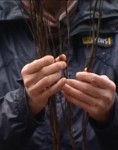
Tarr Steps is a clapper bridge (a bridge constructed using unmortared stone slabs) over the River Barle in Exmoor National Park in Somerset. It’s at least 600 years old — it is referenced in primary sources starting in the 1400s — but some theories date it to the Bronze Age, as early as 1000 B.C. With 17 spans stretching 180 feet across the river, Tarr Steps is the longest clapper bridge in Britain.
 On December 22nd, three-quarters of that length was swept away by the record-breaking rain that swelled the Barle ten feet deeper than its usual level. Even the largest slabs — the biggest one weighs two tons, is eight feet long and five feet wide — were powerless against the worst Somerset floods in living memory. So were trees, some of which were uprooted and driven through the bridge aiding in its decimation.
On December 22nd, three-quarters of that length was swept away by the record-breaking rain that swelled the Barle ten feet deeper than its usual level. Even the largest slabs — the biggest one weighs two tons, is eight feet long and five feet wide — were powerless against the worst Somerset floods in living memory. So were trees, some of which were uprooted and driven through the bridge aiding in its decimation.
 This isn’t the first time Tarr Steps has been damaged by river floods. Over the years the riverbed has silted up, so even when it’s not swelled by massive rains the river level is higher than it once was which puts the bridge closer to the water’s edge. The spans now are just three feet above normal water level. The picture at right is from a series of Sights of Britain issued with purchase of Senior Cigarettes in 1937. You can see more of the piers than you can today. According to local lore, there used to be enough room under the spans for deer to walk under.
This isn’t the first time Tarr Steps has been damaged by river floods. Over the years the riverbed has silted up, so even when it’s not swelled by massive rains the river level is higher than it once was which puts the bridge closer to the water’s edge. The spans now are just three feet above normal water level. The picture at right is from a series of Sights of Britain issued with purchase of Senior Cigarettes in 1937. You can see more of the piers than you can today. According to local lore, there used to be enough room under the spans for deer to walk under.
 Nowadays seeing the entire bridge underwater is not uncommon, and many slabs have been dragged downriver by more serious floods. The great flood of 1952 did so much damage that the army was called in to help put the pieces back together, but this is the most ruined its ever been that anyone can remember. After the waters subsided in 1952, thick steel hawsers were strung across the river 300 yards upstream from the bridge. Their aim was to capture trees, branches and other debris before they could hurtle through Tarr Steps. The poor cables didn’t stand a chance this year. They snapped under the pressure and now look like the frayed ends of a rope.
Nowadays seeing the entire bridge underwater is not uncommon, and many slabs have been dragged downriver by more serious floods. The great flood of 1952 did so much damage that the army was called in to help put the pieces back together, but this is the most ruined its ever been that anyone can remember. After the waters subsided in 1952, thick steel hawsers were strung across the river 300 yards upstream from the bridge. Their aim was to capture trees, branches and other debris before they could hurtle through Tarr Steps. The poor cables didn’t stand a chance this year. They snapped under the pressure and now look like the frayed ends of a rope.
Thankfully in 1952 they had the foresight to number the slabs so they could be puzzled back together after future floods. The repair work will be much harder this time because the damage is so much greater than it has been before and because the water levels are so high it’s going to take a while before crews can even begin to locate the missing slabs.
See what’s left of the bridge, the uprooted trees lining the banks, the busted cables and the delighted kayakers taking advantage of the missing Tarr Steps to travel the length of the river in this ITV story.